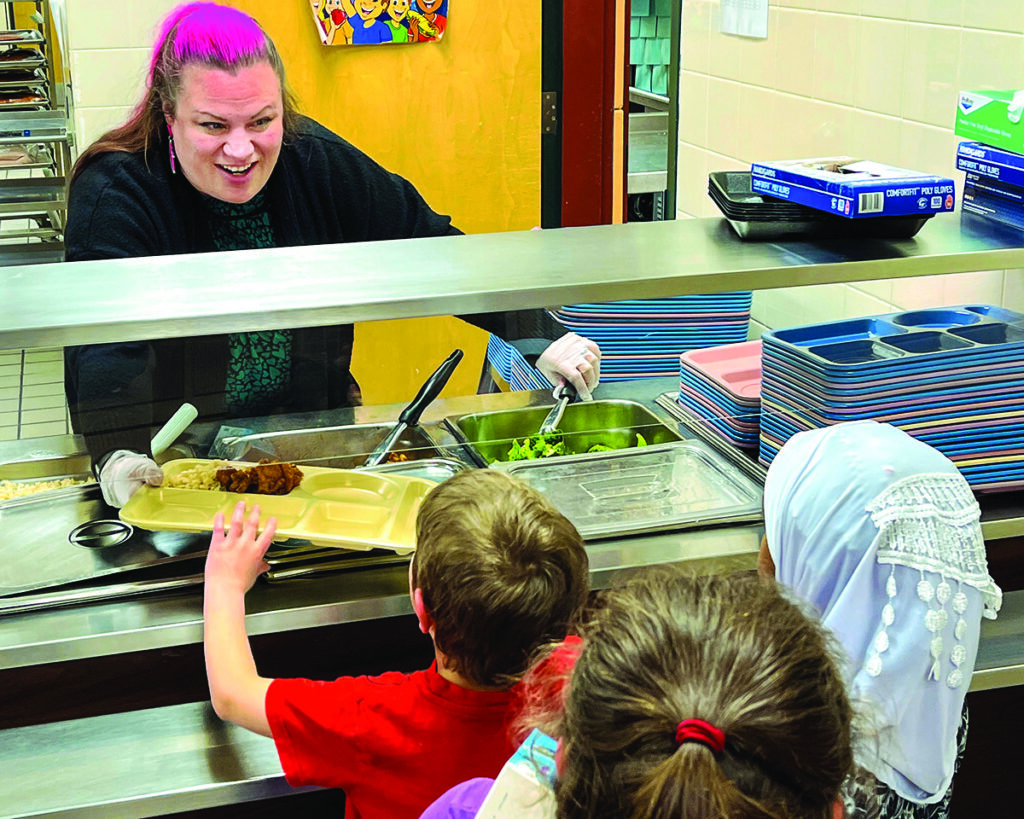
Moorhead food services director Ashley Schneider dishes up hot lunch for three youngsters at Ellen Hopkins Elementary School.
Nancy Edmonds Hanson
Any parent of a picky eater can sympathize with the challenge that school lunch managers face – blending the foods children most like to eat into menus that balance good taste with good nutrition.
Now multiply that challenge by, say, 7,000, and you may begin to understand the challenge faced by Moorhead Public Schools food service director Ashley Schneider and her staff of 60. Five days a week times nine months per year, they’re charged with preparing breakfast and lunch for boys and girls with vastly different ideas of what best soothes their appetites.
And they do it under stringent nutritional guidelines prescribed by the U.S. Department of Agriculture.
“We try to take very popular menu items like taco-in-a-bag, pizza and cheesy French bread and balance them with new things our students may not have tried before,” Ashley says of the menus she’s in charge of planning. “We do want them to enjoy their favorites, but have a chance to broaden their palates beyond the food they may eat every day at home.
“Education doesn’t stop when they enter the lunch room. There’s more to life than chicken nuggets.”
Balancing taste, nutrition and kid appeal is more challenging than ever for Moorhead’s “lunch ladies,” who serve breakfast, lunch and a snack to kids from kindergarten through high school. Lingering COVID-era supply issues and hiccups in manufacturers’ ability to meet federal nutrition standards complicate the picture, and at a time when the number of meals served has been going up.
Ashley estimates that Minnesota’s decision to provide free meals to all students has increased the number going through her department’s breakfast lines by about 5%. About 3% more are eating lunch, depending on the entree of the day – a significant boost in a school district in which 7,266 students are enrolled.
At the same time, the U.S. Department of Agriculture has issued new nutritional guidelines for the coming school year that are being tried out now. “This is our wiggle year for figuring out how to apply them,” the director says. The most significant change is a reduction in the amount of sodium (salt) that will allowed in 2024-25. The rules will be mandated for all public schools (and some private) that receive federal funding for food service.
“At home, we can modify meals to suit our family’s taste. Here in school, we don’t have that flexibility,” she says. “We’re trying to find ways to punch up the taste instead of using salt.” Her department is turning to other spices to try to make up for the flavor that’s lost – garlic powder, Italian seasoning, mustard and some spice rubs they’ve created to add a little more zest.
The size of breakfast and lunch portions is regulated by the USDA. There has been no change in those parameters. “They’re still the same as before,” she asserts.
The hot entrees dished up daily by “lunch ladies” as students pass down the line are only part of each day’s menu. Besides that spaghetti or sweet’n’sour chicken or its cold alternative, usually a sandwich, they pass a rainbow of additional fruits and vegetables chosen to appeal to the eye and pique their curiosity to explore selections not always found in the fridge at home.
Four to five fresh vegetables and two or three fruits are typically served on the fresh bar. It’s stocked each day with a changing rainbow of foods. Plenty are familiar, like the ever-popular oranges, apples and carrots. Others, though, may open new door to those brave or curious enough to taste them. Kiwi, for example, has been featured this week.
Unfamiliar veggies, too, may turn up on the fresh bar or the hot food line. “Kohlrabi has been a huge success story,” Ashley says. So were roasted brussels sprouts when they debuted last month: “They have such a negative connotation, but they were the talk of the lunchroom. Most of the schools ran out of them.” In the fall, “beets and sweets” – roasted beets and sweet potatoes – were a revelation to many. Even standards like broccoli and cauliflower are typically roasted to punch up their flavor.
Bland canned vegetables are definitely off the table. Fresh is the rule. Thanks to a USDA Farm to School grant, Moorhead’s program emphasizes locally grown foods, from potatoes (white or sweet), broccoli, radishes and beets from area fields to Minnesota-raised chicken and beef. Regionally grown foods will be spotlighted March 21, designated as Minnesota Foods Day.
And the adventure even extends to carbohydrates. “When we served roasted chicken drumsticks with quinoa, the kids who already knew what quinoa was were very excited. They told their friends all about it,” Ashley observes.
The food service director recognizes that some students inevitably complain about their meals at school – foods they either don’t like, or, conversely, don’t think they get enough of. She says, “I hope parents realize that’s mostly a matter of the choices they make themselves, not all the options the food service offers them.
“We try to normalize new choices and get the kids to try foods they wouldn’t be exposed to outside the cafeteria,” Ashley concludes. “By the time they reach high school, kids are usually pretty much set in their ideas of what they like and don’t like.
“But if we can capture them at a young age when they’re still curious, they may like that new, nutritious food for a lifetime.” She sighs, and adds, “At the very least, they’ll be able to say, ‘I did actually try that, but I don’t like it.’”


